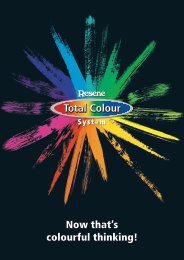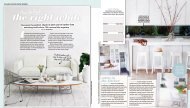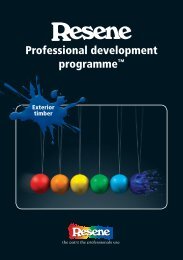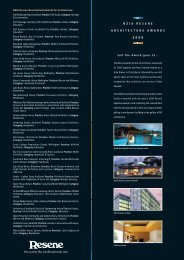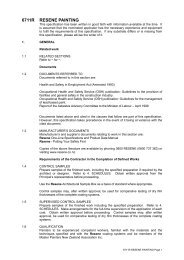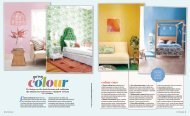Colour Choices - choose colour with creativity and ... - Resene
Colour Choices - choose colour with creativity and ... - Resene
Colour Choices - choose colour with creativity and ... - Resene
You also want an ePaper? Increase the reach of your titles
YUMPU automatically turns print PDFs into web optimized ePapers that Google loves.
<strong>Resene</strong> Jumpstart<br />
Guidelines for using <strong>colour</strong><br />
Nature conditions us to expect balance <strong>and</strong> harmony. It offers us guidelines<br />
for the use of <strong>colour</strong> <strong>and</strong> provides us <strong>with</strong> some basic principles.<br />
The darkest value at our feet e.g. forest floor<br />
The medium level at eye level e.g. tree trunks<br />
The lightest value above us e.g. sky<br />
Underst<strong>and</strong>ing <strong>colour</strong><br />
Consider carefully before deviating from these natural guidelines. Use<br />
the most intense hues <strong>and</strong> values in areas occupied for short periods of<br />
time, such as formal dining rooms, hallways, staff lunchrooms, laundries<br />
<strong>and</strong> entrances. Avoid monotony <strong>and</strong> treat the eye <strong>and</strong> psyche to at least<br />
a moderate variety. Visual stimulus or relief is vital. Harmonious <strong>colour</strong><br />
selections are created by a pleasing relationship of the three dimensions<br />
of <strong>colour</strong>: hue, intensity <strong>and</strong> value.<br />
Using correct proportions of <strong>colour</strong> ensures that your scheme will be<br />
aesthetically pleasing. A touch of contrasting <strong>colour</strong> may be lively <strong>and</strong><br />
exciting but too much can become uncomfortable. On the other h<strong>and</strong>, too<br />
much moderation produces dullness. Personal taste <strong>and</strong> preferences are<br />
the most important considerations in choosing a <strong>colour</strong> scheme.<br />
Think of <strong>colour</strong> as a chameleon:<br />
• It changes depending upon accent <strong>colour</strong>s.<br />
• It is influenced by adjacent <strong>colour</strong>s.<br />
• White or beige <strong>colour</strong>s will take on the tint of adjacent hues.<br />
• Large areas intensify <strong>colour</strong>s.<br />
Finally, think about proportions of <strong>colour</strong>s. A basic rule using two thirds<br />
one <strong>colour</strong> <strong>and</strong> one third another is always successful.<br />
9



